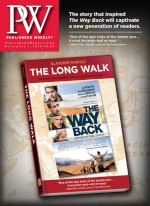Amazon's latest press release about the state of its e-book sales put forth this statistic: its customers are buying more bestsellers in e-book by a ratio of two to one over print. The release last week also stated that the e-tailer has sold more than three times as many e-books in the first nine months of 2010, compared to the same period the previous year.
Amazon's skill at crafting catchy headlines detailing its strong e-book sales is one of the chief things contributing to an impression that the e-book market is bigger than it actually is. Amazon customers may be buying more Kindle edition bestsellers than print bestsellers, but the e-book market is still a relatively small source of income for publishers. Executives across the board insist e-books currently account for 10% to 15% of revenue.
Hoping to get a sense of how frontlist bestsellers are really performing in digital compared to print—and get a snapshot of the e-book market in the process—PW ran down the performance of a handful of current hit titles. To do so, we asked Amazon for a list of its bestselling Kindle editions over the past 30 days. We then asked publishers for a ratio of print to e-book sales for their frontlist titles that are on that list. The numbers, which are for lifetime sales, show that, measured across all outlets, hardcovers are still driving units, though e-books represent an important, and widely varying, slice of total sales.
Amazon E-book Bestsellers1. The Girl Who Kicked the Hornet's Nest by Stieg Larsson
(Knopf, May 2010)*
67% in print; 33% in digital2. The Girl with the Dragon Tattoo by Stieg Larsson
(Knopf; Sept. 2008)*3. Freedom by Jonathan Franzen
(Farrar, Straus, and Giroux; Aug. 2010)
75%–70% in print; 25%–30% in digital4. The Girl Who Played with Fire
by Stieg Larsson
(Knopf, July 2009)*5. Fall of Giants by Ken Follett
(Dutton; Sept. 2010)
publisher would not provide individual figures**6. Obama's War by Bob Woodward
(Simon & Schuster; Sept. 2010)
80% in print; 20% in digital7. American Assassin by Vince Flynn
(Atria; Oct. 2010)
67% in print; 33% in digital8. The Lost Hero by Rick Riordan
(Disney Publishing; Oct. 2010)***
80% in print; 20% in digital9. The Reversal by Michael Connelly
(Little, Brown; Oct. 2010)
74% in print; 26% in digital [This figure was listed incorrectly in our print edition]10. Safe Haven by Nicholas Sparks
(Grand Central; Sept. 2010)
85% in print; 15% in digital*A Random House spokesperson said that Larsson's entire Millennium trilogy is selling 82% in print overall (accounting for hardcover, trade, and mass market) and 18% in digital. We did not request individual statistics on the older books in the series—Girl with the Dragon Tattoo and The Girl Who Played with Fire—because they were released more than a year ago.
**A Penguin spokesperson gave the following statement: "We can't give specific title information, but we will tell you that across our bestsellers there is a wide range of percentages—from 12% to 30% of market share during the first few months of publication."
***A Disney spokesperson qualified that Riordan's e-book numbers are notably higher than the house usually sees on its titles, likely because his middle-grade novel, which was published on October 12, is having significant crossover appeal with adults.



 Volume 257
Issue 43
11/01/2010
Volume 257
Issue 43
11/01/2010





